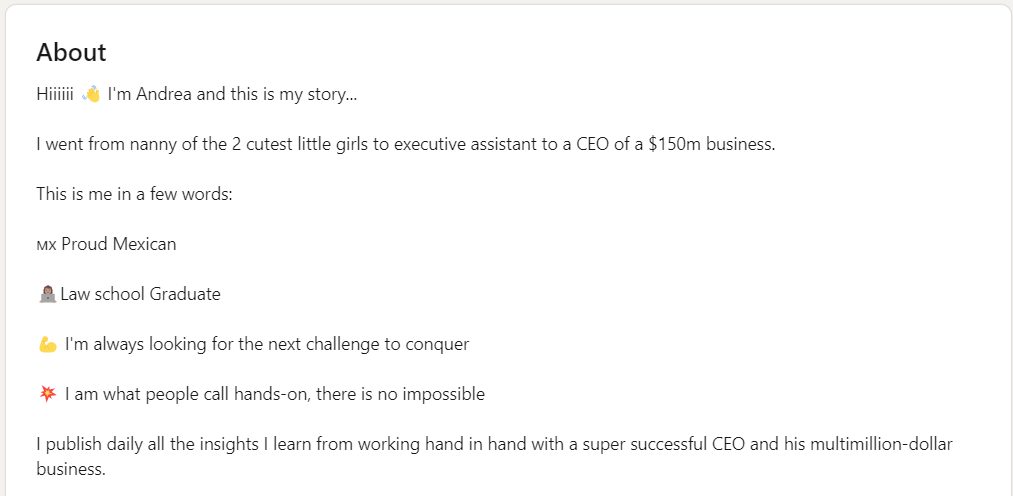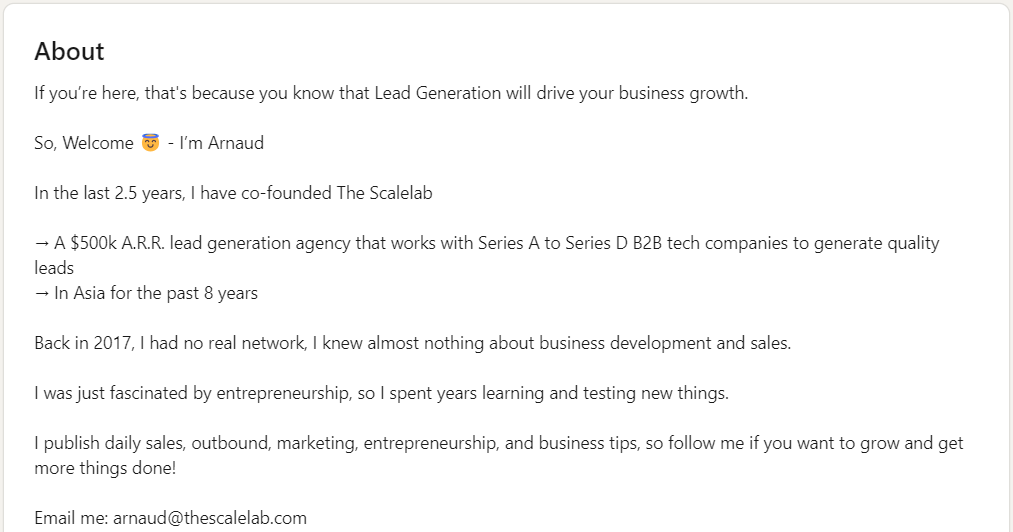In today’s hyper-connected world, personal branding on social media is key to stand out from the crowd. With billions of people using social media platforms like Facebook, Instagram, Twitter, and LinkedIn, the competition for attention has never been fiercer.
Your LinkedIn page is your professional business card. When you are about to meet someone you don’t know, your first reflex is generally to check their LinkedIn profile. And people do the same with you! It can even be a considerable asset to your business. You can find clients but also recruit key talent for your company.
But what does it take to create a personal brand that cuts through the noise and captures the attention of your target audience?
What is Personal Branding?
Personal brand is a widely-recognized and largely-uniform perception or impression of an individual based on their experience, expertise, competencies, actions and/or achievements within a community, industry, or the marketplace at large.
Personal branding is basically how you want to be perceived as a professional.
Why building a Personal Brand?
People tend to feel closer to individuals than to brands or companies. When people engage with personal brands on social media, they often feel like they are interacting with a real person rather than a marketing machine.
By building a personal brand on social media, you can leverage this human connection to build relationships with your audience, grow your influence, and create a loyal following.
More specifically, a strong personal brand can help you:
🎯 Stand out of the crowd
🎯 Position as an expert
🎯 Be more trusted
🎯 Break the barrier between your company and your prospects
🎯 Build deeper relationships
🎯 Gain career opportunities
How can you build a strong Personal Brand in 7 steps ?
Step #1: Identify your target audience
As every good marketing strategy, you have to know who you want to talk with. Those questions might help you guide your research:
- What are their interests?
- What are their issues/fears?
- What type of content do they appreciate ?
- What information do they look for?
- What are their functions?
- What are their sectors of activity?
Step #2: Take stock of who you are and define your value proposition
You have to define clearly who you are and what you want others to know about you. Let’s be clear, being a good person on Internet while being a bad person in real life is not an effective personal brand strategy.
Be true to who you are and define what is your unique value proposition, as a person:
- What are your skills and strengths?
- What is your very own specialty?
- What service/product do you provide?
- What are your interests?
- What values are you driven by?
- What is your tone of voice? / How do you want to talk with your audience?
Based on those questions, you are now able to define what your key message will be.
Step #3: Define objectives
It may seem formal and stressful to define objectives but they will help you keep track of your performance. They should be based on the great goals you want to achieve through your personal branding strategy : Establish yourself as a thought leader in your industry? Attract new clients? Be offered job opportunities? Recruit top talent?
Here are some examples of objectives you can set:
- Increase my network by 5% within 6 months
- Increase my response rate to in-mails to 40% within 6 months
- Obtain 2 new clients through LinkedIn within a year
- Maintain a posting frequency of 1 post per week
- Attract 100 engineering profiles within 6 months
- Receiving 3 in-mails for job opportunities per month
Of course, they will be dependent on your current performance.
Step #4: Optimize your LinkedIn profile
LinkedIn is the social network of choice to be known as a professional. By mastering the different features of LinkedIn, you can transform your profile into a real mini website.
✅ Choose a professional but authentic profile picture
Your face should be clearly visible, the background uniform and the framing at shoulder height. A person scrolling on their news feed should be able to recognize you easily, and spontaneously stop on your post.
💡 The recommended format for profile pictures on LinkedIn is 400 x 400 pixels.
Some good examples:
✅ Create a powerful banner
As every good website, your LinkedIn page should have a nice and attractive banner. Generally, companies offer banners to their employees so don’t hesitate to contact your company’s communications department. If you are acting independently, leave room for your design talents.
Your banner is the billboard of your LinkedIn profile. Do not neglect it and make it lively! You can put so much valuable information there such as:
- Your slogan
- A 1 sentence pitch of your product/service
- A specific offer you have at the moment
- A call-to-action
💡 The recommended format for banners on LinkedIn is 1584 x 396 pixels.
Some good examples:
✅ Turn your profile to creator mode
The creator mode is key to developing your personal brand. You will access more features for your LinkedIn profile. How to do it? On your LinkedIn profile, scroll down to “Resources” and click on “Creator mode”.

The button “Connect” will be replaced by “Follow” and your followers counter will be displayed. You will have access to more statistics and tools, such as the newsletter. You can also mention the topics you are consistently talking about with the section “Talks about”.
Creator Mode helps you bring between 15 and 35% more reach (Richard van der Blom). A simple and effective opportunity to boost your performance! 🚀
✅ Update your title
That’s a very important point. It’s one of the first things that a visitor will learn about you when visiting your profile. It’s also visible when you appear on people’s LinkedIn feed. There is no golden rule for writing it. We should understand what you do and for whom. Your visitor must be able to decide whether it’s relevant for them to follow you. Use the keywords that are relevant to your industry and audience.
Some good examples:
✅ Write your presentation
With a good hook in the first lines, you can really make the difference and arouse curiosity. It’s impossible not to read the rest!
It can be short or long, as long as it is easy to scan, with short paragraphs and structuring elements (dashes, emojis). The reader should be able to navigate easily through your presentation.
First off, let’s think about how you would introduce yourself to someone you just met at a networking event. You’d probably start with a friendly greeting and then give a brief overview of your background and what you do. That’s exactly the approach you should take with your presentation section. To create the illusion of a real conversation, speak directly to your audience : “Hi there!” – “If you’re reading this” – “Nice to meet you!”…
Start by introducing yourself in a friendly, conversational tone. Don’t be afraid to show your personality and use casual language. The goal is to make a connection with your audience, so it’s important to come across as approachable and relatable.
Next, talk about your experience and accomplishments in a way that feels natural to you. Share some of the key milestones in your career journey and highlight the skills and expertise that make you unique.
Make sure to keep your presentation section concise and easy to read. Use short paragraphs and bullet points to break up the text and consider using bold or italicized text to highlight key points. You can use emojis to structure your text and make it more human.
Finally, add a call to action at the end of your presentation section. This can be something as simple as inviting people to connect with you on LinkedIn, or it could be a more specific call to action, like encouraging them to check out your website or portfolio.
Some good examples:
And now LinkedIn is even offering Premium members a helping hand from artificial intelligence to write a presentation.

Here’s what LinkedIn wrote for me, as a Marketing & Communication Specialist at Profile Group. First, it proposes a title for my profile:
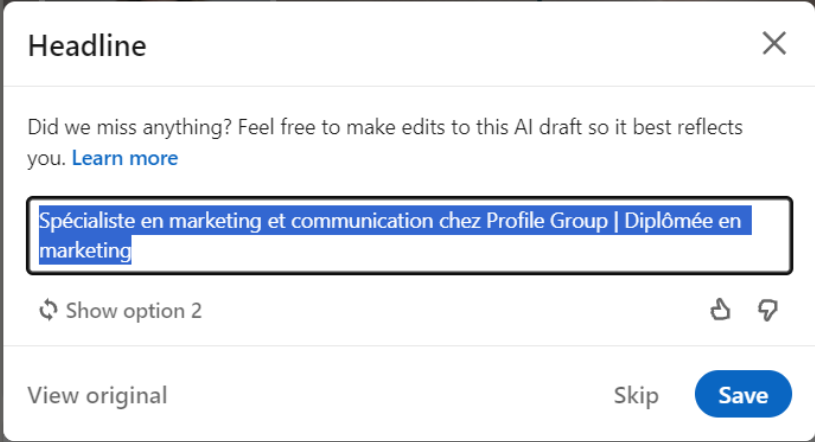
Then it moves to the presentation.
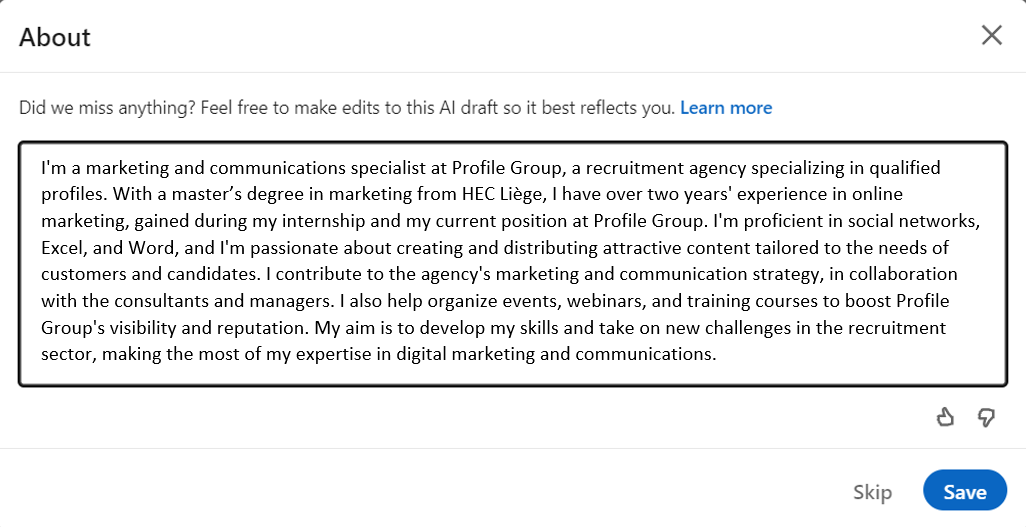
It’s not perfect but it gives you a great basis for creating your description and saves you time! Here is the result with a few tweaks.
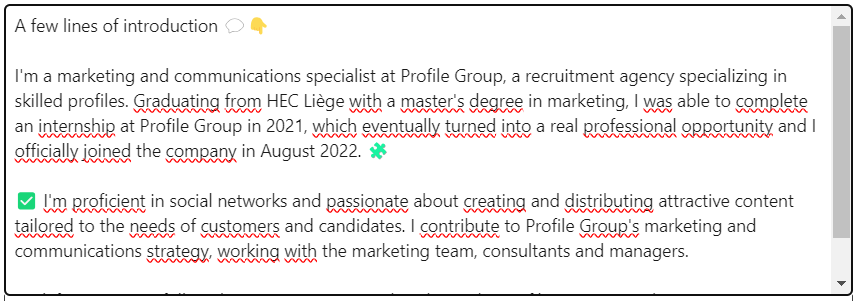
✅ Put key contents in your Featured section
Did you know that you can pin specific contents on your LinkedIn page? This is what it looks like! In this area, you can include:
- Your offers
- A nice article you wrote
- One of your posts that performed exceptionally well
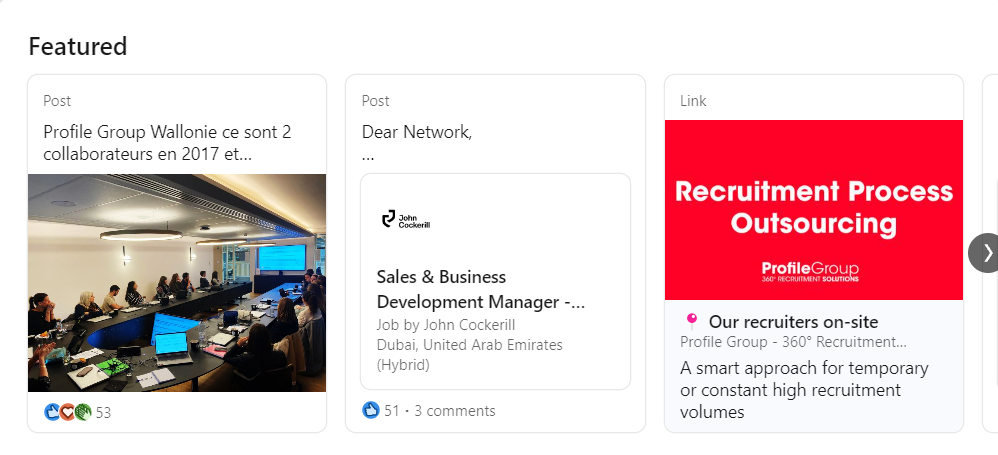
All you have to do is to go to “Add profile section”, “Recommended” and then “Add featured”.
Step #5: Bring value to your audience
Good! People are now connected with you. You now have to provide them with what they wish for by following you: content! 🖋️📸
We can divide content and their purpose into 6 categories: entertaining, informing, educating, inspiring, promoting, relating. You have to give more than you expect to be given. A simple Pareto rule can help you master this philosophy: 20% of promotion vs 80% of other.
One of the keys to creating content that stands out is to focus on your niche. What topics or areas of expertise do you have that make you unique? Identify these areas and create content that showcases your expertise.
People love stories, so try to incorporate storytelling techniques into your content whenever possible. Share personal anecdotes or examples that illustrate your points and make your content more relatable. Injecting humor and personality into your content can help you stand out and make your content more memorable. Don’t be afraid to show your personality and use humor where appropriate.
Here are some best practices to write a nice post:
- Take care of the two first lines: give people the will to click on “see more”
- Use emojis to structure your text: not too much, not too little
- Write short paragraphs
- Don’t forget your call-to-action at the end: what should they do now they’ve consumed your content?
- Use a striking and high quality visual (a video, a picture, an image, a carrousel, …)
- Add relevant hashtags (between 4 and 6)
Your content also allows you to build your brand through a striking graphic charter. Choose the colors you will use on a recurring basis, find two or three fonts you like and let’s go.
You’ll never do a job as professional as a graphic designer, but that’s not what we’re looking for here. We’re looking for au-then-ti-city!
💡 Canva will be your best ally here.
💡 ChatGPT as well but use it as an assistant, not as a duplication of your person.
Step #6: Interact with your audience and grow your network
You can’t wait passively for people to come to you. That’s the moment to connect with people that have an interesting network for you or that could be interested in your services. Interacting with other LinkedIn users is also recognized by the algorithm. You can grow the reach of your posts by 20% by reacting to others’ content (Richard van der Blom).
Moreover, it shows that you are interested in what others have to say and are willing to engage in conversations.
Step #7: Measure your success
Do you know the Social Selling Index ? LinkedIn created this measure to assess the performance of your profile. You can discover yours right here !
This measure is based on four areas :
- Establishing your professional brand
- Finding the right people
- Engaging with insights
- Building relationships
LinkedIn’s Social Selling Index can be a useful tool for measuring and improving your social selling efforts on the platform, as it provides a clear breakdown of the areas where you are excelling and where you may need to improve.
Besides the Social Selling Index, LinkedIn provides you with many interesting statistics :
- Profile views
- Engagement metrics such as likes, comments, shares
- Followers growth
- Demographic data about viewers : function, location, company, sector, company size.
To sum it up
Building a strong personal brand on LinkedIn is essential for success in today’s digital world. By following the tips outlined in this article, you can establish yourself as a thought leader in your industry, connect with your network, receive exciting job opportunities and achieve your goals on the platform.
But remember, building a personal brand takes time and effort. By staying consistent and measuring your success, you can continue to improve your brand and create new opportunities for yourself.
So, take the first step today and start building your personal brand on LinkedIn!
Looking for your dream job?











